
Hawaii
Hawai’i Worldwide Combined Reporting Bill Cites ITEP Data
February 25, 2025
House Bill 116 in this year’s state legislative session in Hawai’i cites ITEP data on the revenue potential of worldwide combined reporting (WWCR). (For more on WWCR, read our recent report here.)
Hawai’i Appleseed: How a Second Trump Presidency Could Impact the Pocket Books of Hawaiʻi’s Working Families
December 22, 2024
With President-elect Trump preparing to return to the White House in 2025, it’s worth examining how his proposed policies could impact Hawaiʻi’s economy, tax system and the household budgets of local working families. Read more.
Hawai’i Public Radio: Concerns Rise for Low-Income Families Over Legislature’s Recent Tax Cut Measure
May 16, 2024
Most Hawaiʻi residents will likely see lower income taxes next year due to a measure recently passed by the state Legislature. However, some advocates are concerned that those changes could also limit tax assistance for those who need it the most. Lawmakers are calling it the biggest tax cut in the state’s history: about $5 billion over the next five years.
ITEP’s Miles Trinidad Testifies Against Weakening Hawai’i’s Estate Tax
April 9, 2024
HB 2653 would only exacerbate the regressive nature of Hawai’i’s state and local tax system and compound the preferential treatment of income derived from wealth.
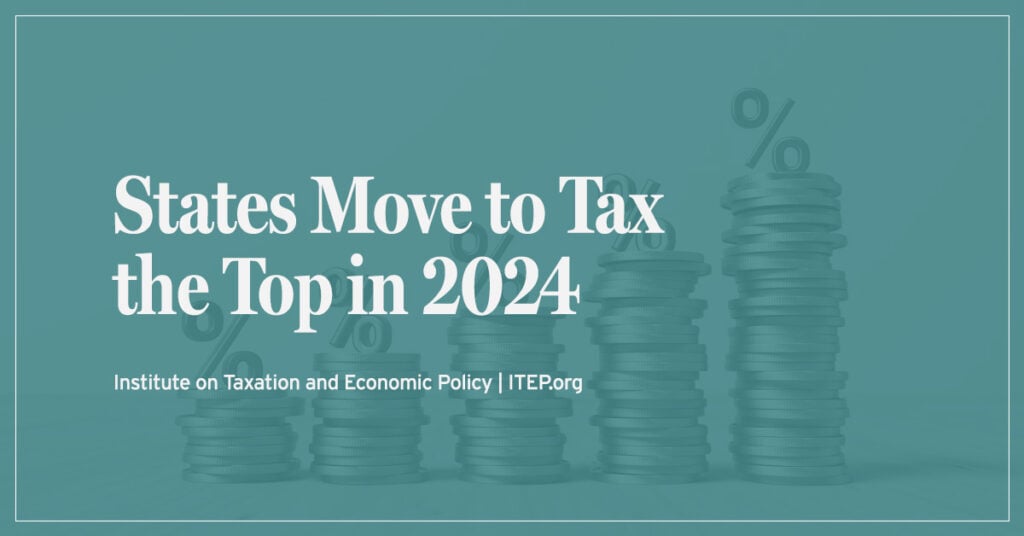
These forward-thinking states are demonstrating the wide variety of options for policymakers who want to raise more from the wealthiest people, rein in corporate tax avoidance, create fair tax codes and build strong communities.
Hawai’i Appleseed Center for Law and Economic Justice: Rebalance Hawaii’s Upside-Down Tax Code to Achieve Prosperity for All
January 24, 2024
Our state tax code makes the situation worse. A comprehensive analysis of state and local taxes across the country shows that Hawaii is the third-worst state when it comes to taxing struggling working families. Households in the lowest income category pay an effective tax rate of 14.1%, while the richest 1% pay an effective tax rate of 10.1%
Hawaiʻi Budget & Policy Center: Closing the Capital Gains Loophole
February 1, 2023
Eliminating the preferential tax treatment of capital gains income will increase tax fairness and help fund our future. Read more.
Hawai’i Budget & Policy Center: Expanding Economic Opportunity with the Hawai’i EITC
February 7, 2022
Hawai’i’s working families continue to struggle with the nation’s highest gap between median earnings and the cost of living, and this difficult reality has only been made harsher by the COVID-19 pandemic. In fact, more than a third of Hawai’i households had at least some difficulty paying for their monthly expenses in December of 2021. […]
Hawai’i Budget and Policy Center: Hawai’i’s Earned Income Tax Credit: Next Steps
February 20, 2020
In 2017, Hawaiʻi passed legislation to create a state EITC.11 The new law allowed qualified taxpayers to claim a state tax credit beginning in 2018. The state tax credit amounts to 20 percent of the federal EITC but, unlike its federal counterpart, Hawaiʻi’s tax credit is not refundable. That is, if the filer owes less […]
Hawai’i Public Radio: Corporate Tax Loophole Costs Hawaii $38 Million Annually
February 20, 2019
Hawaii lawmakers are missing out on millions in potential tax revenue. That is the conclusion of a report from the Institute on Taxation and Economic Policy. The ITEP found that a loophole in Hawaii’s tax code allows multinational corporations to avoid paying state corporate income taxes, resulting in a loss of $38 million in revenue annually. Read […]
The Garden Island: Gap Keeps Growing Between Rich, Poor
October 25, 2018
The study finds that those in the bottom fifth of the income spectrum in Hawaii pay 15 percent of their income in state and local taxes, while those in the top 1 percent pay only 8.9 percent, “which exacerbates inequality in our state,” according to a press release about the study.
Hawaii Public Radio: Hawaii Tax System Places Larger Burden on Low Income Residents
October 24, 2018
Low-income residents in Hawaii are paying a higher share of their income in taxes than higher level earners. That is the conclusion of a recent report from the Institute on Taxation and Economic Policy titled Who Pays? The Hawaii tax system is considered highly regressive, due to heavy reliance on the General Excise Tax, or GET. This is despite a progressive, graded state income tax and the lowest property taxes in the nation.
Hawai’i Budget & Policy Center: Hawaii’s Tax System Exacerbates Inequality
October 23, 2018
A new report out from the Institute on Taxation and Economic Policy (ITEP) provides the vital statistics for each state’s tax system. It lays out, in clear and compelling numbers, the sobering message that Hawaiʻi taxes—and those in the United States on average—increase inequality between rich and poor.
Big Island Now: STUDY: Hawai‘i’s Low-Income Taxpayers Carry 2nd Highest Tax Rate
October 17, 2018
The main cause of the heavy tax burden on those making the least in Hawaiʻi is the General Excise Tax (GET). Families in the lowest fifth spend 10.5% of their meager incomes on the GET, while the top 1% spend only 1.2% of their large earnings. In other words, those at the bottom spend 8.75 times more of their income on the GET than do those at the top.
Hawaii: Who Pays? 6th Edition
October 17, 2018 • By ITEP Staff
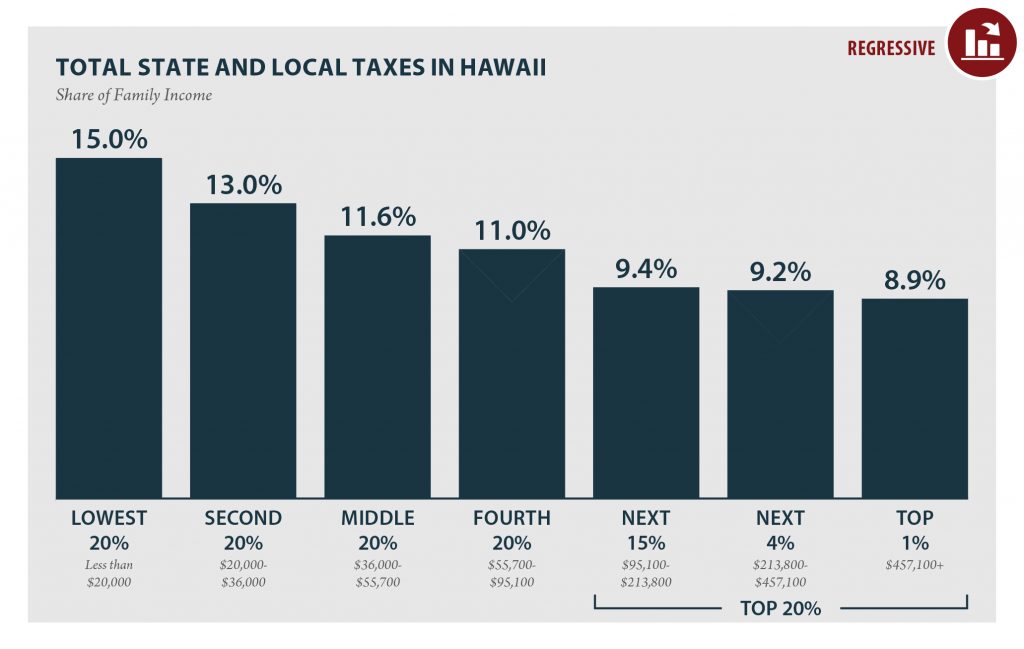
HAWAII Read as PDF HAWAII STATE AND LOCAL TAXES Taxes as Share of Family Income Top 20% Income Group Lowest 20% Second 20% Middle 20% Fourth 20% Next 15% Next 4% Top 1% Income Range Less than $20,000 $20,000 to $36,000 $36,000 to $55,700 $55,700 to $95,100 $95,100 to $213,800 $213,800 to $457,100 over $457,100 […]
Tax Cuts 2.0 – Hawaii
September 26, 2018 • By ITEP Staff
The $2 trillion 2017 Tax Cuts and Jobs Act (TCJA) includes several provisions set to expire at the end of 2025. Now, GOP leaders have introduced a bill informally called “Tax Cuts 2.0” or “Tax Reform 2.0,” which would make the temporary provisions permanent. And they falsely claim that making these provisions permanent will benefit […]
Hawaii News Now: Nonprofit to State on Tax Savings for Low-Income Families: Check Your Math
March 29, 2018
The state miscalculated the benefits of the federal tax overhaul to low-income families in Hawaii, a new analysis concludes. The source of the confusion: The scope of the tax savings that the child tax credit benefit would offer very low-income families (those earning up to $10,000 a year).
Honolulu Star Advertiser: New Tax Benefits Likely Overstated for Hawaii’s Poorest
March 29, 2018
A nonpartisan Washington, D.C.-based nonprofit, the Institute on Taxation and Economic Policy, has estimated that Hawaii’s richest 1 percent, represented by households earning over $554,230, would save $39,420 on average next year under the new law. The group also figured that Hawaii taxpayers earning less than $26,620 would save $130 on average in taxes.
Hawai’i Budget & Policy Center: Effects of Federal Tax Cuts in Hawai‘i: Correcting the Record
March 28, 2018
Although corporate taxes are not reported on individual income tax forms, corporate tax cuts benefit those who own stocks, and the vast majority are owned by upper-income individuals. For that reason, ITEP included corporate tax breaks in its analysis of the federal tax law.
How the Final GOP-Trump Tax Bill Would Affect Hawaii Residents’ Federal Taxes
December 16, 2017 • By ITEP Staff
The final tax bill that Republicans in Congress are poised to approve would provide most of its benefits to high-income households and foreign investors while raising taxes on many low- and middle-income Americans. The bill would go into effect in 2018 but the provisions directly affecting families and individuals would all expire after 2025, with […]
How the House and Senate Tax Bills Would Affect Hawaii Residents’ Federal Taxes
December 6, 2017 • By ITEP Staff
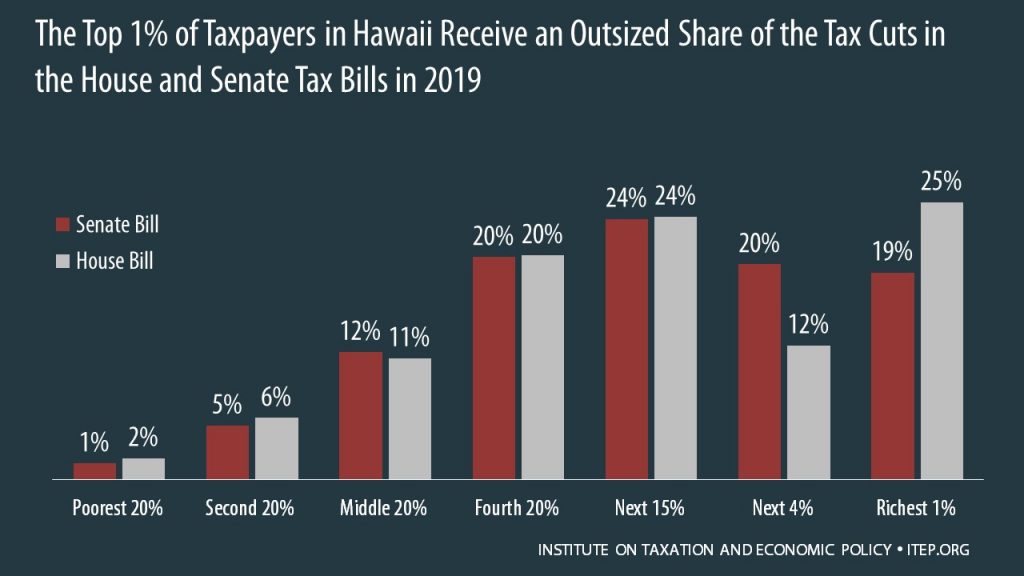
The House passed its “Tax Cuts and Jobs Act” November 16th and the Senate passed its version December 2nd. Both bills would raise taxes on many low- and middle-income families in every state and provide the wealthiest Americans and foreign investors substantial tax cuts, while adding more than $1.4 trillion to the deficit over ten years. The graph below shows that both bills are skewed to the richest 1 percent of Hawaii residents.
How the Revised Senate Tax Bill Would Affect Hawaii Residents’ Federal Taxes
November 14, 2017 • By ITEP Staff
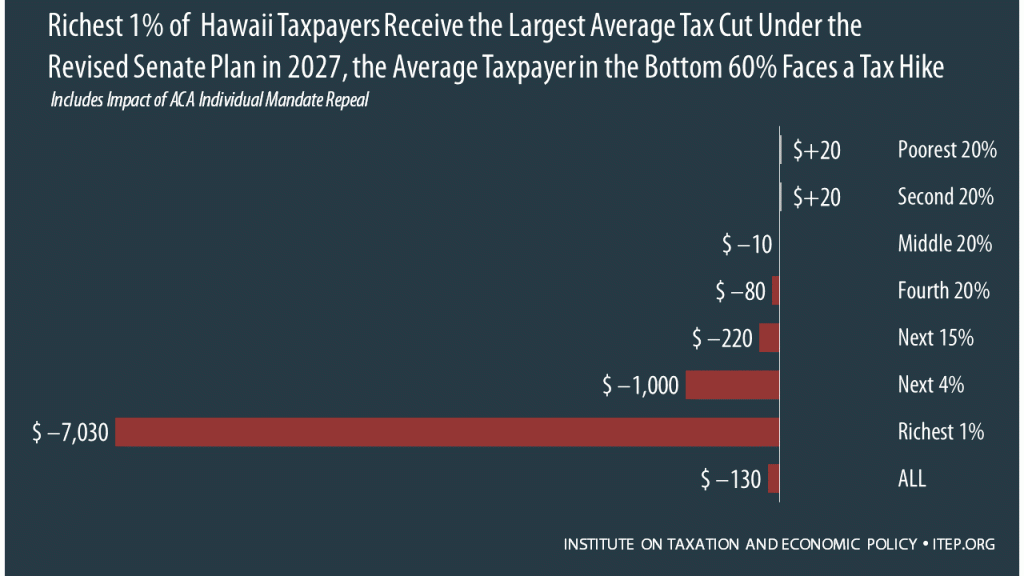
The Senate tax bill released last week would raise taxes on some families while bestowing immense benefits on wealthy Americans and foreign investors. In Hawaii, 40 percent of the federal tax cuts would go to the richest 5 percent of residents, and 16 percent of households would face a tax increase, once the bill is fully implemented.
How the House Tax Proposal Would Affect Hawaii Residents’ Federal Taxes
November 6, 2017 • By ITEP Staff
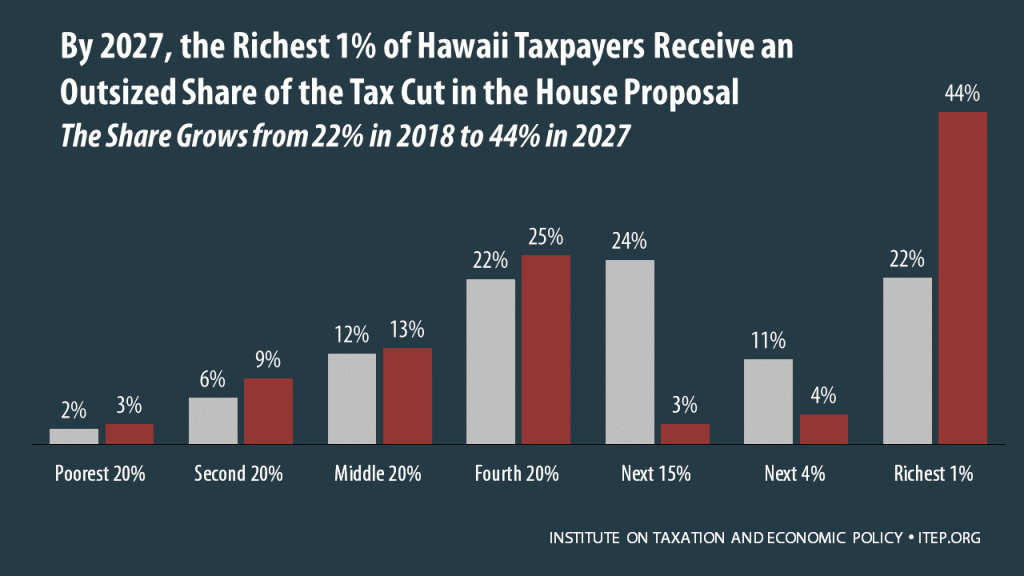
The Tax Cuts and Jobs Act, which was introduced on November 2 in the House of Representatives, includes some provisions that raise taxes and some that cut taxes, so the net effect for any particular family’s federal tax bill depends on their situation. Some of the provisions that benefit the middle class — like lower tax rates, an increased standard deduction, and a $300 tax credit for each adult in a household — are designed to expire or become less generous over time. Some of the provisions that benefit the wealthy, such as the reduction and eventual repeal of the estate…
GOP-Trump Tax Framework Would Provide Richest One Percent in Hawaii with 59.8 Percent of the State’s Tax Cuts
October 4, 2017 • By ITEP Staff
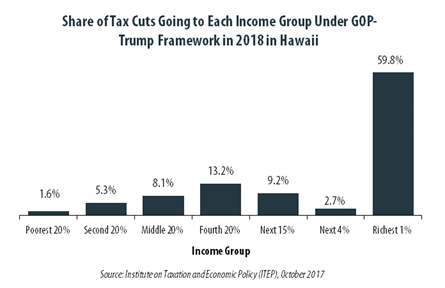
The “tax reform framework” released by the Trump administration and congressional Republican leaders on September 27 would not benefit everyone in Hawaii equally. The richest one percent of Hawaii residents would receive 59.8 percent of the tax cuts within the state under the framework in 2018. These households are projected to have an income of at least $470,500 next year. The framework would provide them an average tax cut of $39,750 in 2018, which would increase their income by an average of 3.5 percent.
In Hawaii 32.2 Percent of Trump’s Proposed Tax Cuts Go to People Making More than $1 Million
August 17, 2017 • By ITEP Staff
A tiny fraction of the Hawaii population (0.3 percent) earns more than $1 million annually. But this elite group would receive 32.2 percent of the tax cuts that go to Hawaii residents under the tax proposals from the Trump administration. A much larger group, 46.6 percent of the state, earns less than $45,000, but would receive just 9.1 percent of the tax cuts.
